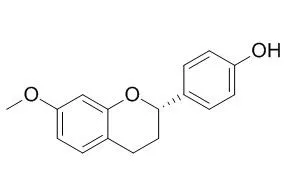| In vitro: |
| Planta Med. 1991 Oct;57(5):437-9. | | Cytotoxic activity of Amaryllidaceae alkaloids from Crinum augustum and Crinum bulbispermum.[Pubmed: 1798796 ] |
METHODS AND RESULTS:
The cytotoxic activity of five minor Amaryllidaceae alkaloids and one flavan isolated from Crinum augustum Rox and Crinum bulbispermum Milne were tested on human leukemic Molt 4 cells.
CONCLUSIONS:
Whereas the crinine-type alkaloids (6 alpha-hydroxycrinine, powelline) and the new type augustamine did not even inhibit the growth of Molt 4 cells, the lycorine-type alkaloid (pratorinine) and the crinine-type alkaloid (6 alpha-hydroxybuphanisine) showed a moderate cytotoxic activity and the flavan (4'-Hydroxy-7-methoxyflavan) showed an important cytotoxic effect. | | Nat Prod Res. 2016;30(7):761-7. | | A new flavan from the Drynaria bonii H. Christ rhizomes.[Pubmed: 26230303 ] | In Vietnam, the medicinal plant Drynaria bonii H. Christ is used for the treatment of osteoporosis, bone fractures, and stimulate the growth of hair, treat tinnitus (Ho 2002; Loi 2004).
METHODS AND RESULTS:
In this article, experiments were designed to investigate the proliferation activity of ethanol, n-hexane, chloroform, ethyl acetate and methanol extracts from D. bonii rhizomes on MG-63 human osteoblast-like cells. The results showed that methanol and hexane extracts had the ability to proliferate MG-63 cells at the concentration varying from 0.1 to 0.01 μg/mL. In particular, at the concentration of 0.01 μg/mL, hexane and methanol extracts illustrated the highest proliferation ratio with 9.31% and 6.16%, respectively.
CONCLUSIONS:
By column chromatography, a new compound named drynaether A (1) and five known compounds uracil (2), 4'-Hydroxy-7-methoxyflavan (3), kaempferol (4), indole-3-carboxylic acid (5) and protocatechuic acid (6) were isolated and identified from the methanol extract.
|
|






 Cell. 2018 Jan 11;172(1-2):249-261.e12. doi: 10.1016/j.cell.2017.12.019.IF=36.216(2019)
Cell. 2018 Jan 11;172(1-2):249-261.e12. doi: 10.1016/j.cell.2017.12.019.IF=36.216(2019) Cell Metab. 2020 Mar 3;31(3):534-548.e5. doi: 10.1016/j.cmet.2020.01.002.IF=22.415(2019)
Cell Metab. 2020 Mar 3;31(3):534-548.e5. doi: 10.1016/j.cmet.2020.01.002.IF=22.415(2019) Mol Cell. 2017 Nov 16;68(4):673-685.e6. doi: 10.1016/j.molcel.2017.10.022.IF=14.548(2019)
Mol Cell. 2017 Nov 16;68(4):673-685.e6. doi: 10.1016/j.molcel.2017.10.022.IF=14.548(2019)